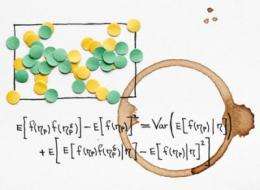Studying random structures with confetti

Chance and probability play a natural role in statistical physics. Inspired by confetti, researchers at the University of Gothenburg, Sweden, gain better understanding of random phenomena and refine the tools that can be used to study them.
"The result of small disturbances to random systems can be illustrated by throwing confetti. If simple rules are constructed at a small scale, it is possible to study the characteristics at a broad level. Small changes at local level can result in widely differing phenomena at global level," says Daniel Ahlberg at the Department of Mathematical Sciences of the University of Gothenburg.
Ahlberg has based his doctoral thesis in mathematical statistics on probabilities and percolation theory, which concerns the studies of random structures. Part of the thesis is a study of a fundamentally simple object: the random structure on a given surface created with the aid of confetti. The question is how the structure is affected by a slight disturbance.
"A small disturbance is sufficient, that is to say a small proportion of the confetti that has been thrown being re-positioned, for the structure of confetti to show completely different characteristics."
Probability models of this type do not have great practical application in themselves, but the phenomena demonstrated provide a pointer to what can be expected when similar physical systems are studied. This may relate for example to how liquid trickles into porous materials or spread of disease in forestry plantations.
Provided by University of Gothenburg


















